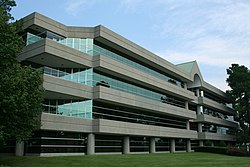This article has multiple issues. Please help
improve it or discuss these issues on the
talk page. (
Learn how and when to remove these template messages)
|

A reverse commute is a round trip, regularly taken, from an urban area to a suburban one in the morning, and returning in the evening. It is almost universally applied to trips to work in the suburbs from homes in the city. This is in opposition to the regular commute, where a person lives in the suburbs and travels to work in the city.
The reverse commuter travels in the opposite direction of the regular daily traffic flow during rush hour, and therefore encounters less road traffic congestion faced by regular commuters. An advantage of this system is the usage of otherwise empty transit capacity: no additional trains or travel lanes are necessary to accommodate people riding or driving from downtown to the outskirts in the morning, and likewise back downtown at night. Train and bus routes may be more sparse in the reverse direction, but the vehicles have to get back somehow for their next journey in most cases. However, track capacity on some railroads (for example, the Long Island Rail Road in the suburbs of New York City) significantly reduces or even eliminates reverse commute options. [1] Hence, transit usage can be lower for reverse-commuters than regular commuters. In some cases, reverse commuting has become quite popular. For example, Metro-North Railroad runs rush hour New Haven Line trains from New York City to Stamford, Connecticut, and the surrounding suburbs to accommodate its many reverse commuters. Low unemployment rates in the suburbs may help to fuel the increase over the past years in reverse commuter ridership. [2] [3] [4]
However, the very reasons commuting makes sense (such as higher employment in the city and lower housing prices in the suburbs) operate against the reverse commuter and so people doing so are less common compared to those going the other way.[ citation needed] However, these traditional schools of thought are changing, especially in Southern and Western US cities, where employment options tend to follow a more decentralized or polycentric model than Midwest or Eastern US cities. For instance, on the Santa Monica Freeway in Los Angeles, there are more vehicles in the morning peak hour heading westbound towards Santa Monica than into Downtown Los Angeles. [5]
An example of reverse commuting can be found in the Washington Metropolitan Area. Due to a combination of ample transit infrastructure and the height limit in downtown, employment options in the area follow a polycentric model, heavily focused in both Downtown and areas such as Arlington, Tysons, Bethesda, and Silver Spring. Companies desiring space in Washington often opt for space in Maryland or Virginia because of the great expense of office space downtown. As such, there are many people who live in Washington and work in Maryland and Virginia, either driving, taking Metrobus, Metrorail, or carpooling. [6]
A significant amount of reverse commuting occurs in the San Francisco Bay Area, where many workers live in San Francisco and work in job centers in Silicon Valley such as Palo Alto, Mountain View, and Cupertino. As of 2013, ridership on Caltrain during peak hours consisted of about 60% traditional commuters and 40% reverse commuters. [7]
References
- ^ Manskar, Noah (January 28, 2017). "LIRR says record ridership shows need for reverse commute, 3rd track". The Island Now. Retrieved 29 December 2021.
- ^ Fessenden, Ford (February 24, 2008). "The Big Commute, in Reverse". New York Times. Retrieved 7 January 2012.
- ^ Prevost, Lisa (August 12, 2007). "Now Arriving: Reverse Commuters". New York Times. Retrieved January 7, 2012.
- ^ "MTA Metro-North Railroad Schedules". Metropolitan Transportation Authority (New York). Retrieved January 7, 2012.
- ^ Shuit, Douglas P. (April 9, 2000). "'New Economy' Puts Commuting Paths in Reverse". Los Angeles Times.
- ^ "Metro beats BART with suburban transit-oriented jobs". GreaterGreaterWashington. February 8, 2010. Retrieved May 2, 2012.
-
^
"Transportation Analysis: Caltrain Peninsula Corridor" (PDF). Retrieved 2021-07-16.
Northbound Traditional Peak AM (22,583), Southbound Reverse Peak AM (15,575), Southbound Traditional Peak PM (22,583), Northbound Reverse Peak PM (15,575)